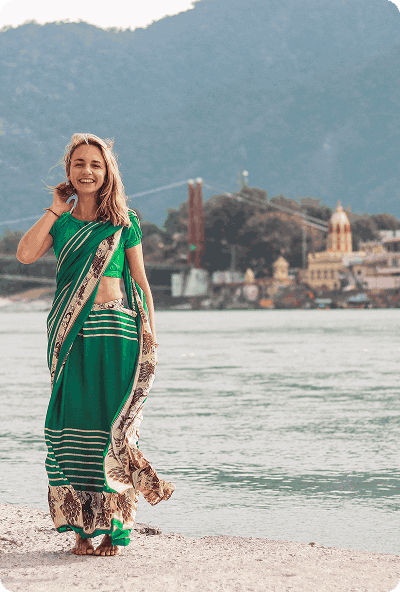Cultural etiquette for visitors
"Respect is not a rule; it's a way of arriving."
Understanding the journey
Yoga originated in India, but too often, the journey to study it here begins with assumptions about how people live, what "authenticity" entails, or how spiritual practice should feel.


This page isn’t here to shame or police. It’s here to offer context so you can show up not just as a student of yoga but as a respectful guest in a place that continues to hold the roots of what you came to learn.
Dress with awareness, not just comfort
India's climate can be hot, humid, and intense, but that doesn't mean anything goes when it comes to what you wear.
In many parts of India, especially outside major tourist zones, modesty remains a cultural norm for both men and women. This has nothing to do with judgment. It's about context. Respect often begins with what we choose to show or cover.

Essential guidelines

Cover shoulders, chest, and knees, especially in villages, temples, and ashrams.

Avoid tight or sheer clothing outside the yoga hall.
Keep a scarf or shawl handy; it’s invaluable for temple visits, modesty, or protection from the mid-day sun.
Practical tips
Swimwear should be modest and covered when not in water.
In ashrams or traditional schools, opt for loose cotton clothing in light colors. It’s not just respectful; it’s practical.
When in doubt, look around. If you’re the only one wearing it, it might be worth reconsidering.
How to behave in ashrams and sacred spaces
Ashrams are not retreats in the Western sense. Temples are not backdrops. These are living, breathing spaces of devotion, study, and often strict discipline.
Sacred protocols
Remove shoes before entering yoga halls, temples, or homes
Avoid touching idols, altars, or ritual items unless invited
Mindful presence
Speak softly. Many ashrams observe silence during certain hours
Public displays of affection, even hand-holding, are best avoided
Respectful engagement
Sit cross-legged or with feet tucked beneath you. Don’t point your feet at teachers, shrines, or elders
Always ask before taking photos, even if others are doing it
Remember:
You are entering a space that holds meaning for others. Your presence has an impact; make it a conscious one.
Communication in India: different rhythm, same heart
India's way of communicating is layered, fluid, and often more nuanced than many Western styles.

You may find the pace slower, the answers softer, or the conversations more circular than direct. That doesn't mean people are avoiding you; it's often a way to maintain harmony.
Understanding the flow
Patience goes a long way. Delays, reschedules, and last-minute changes are part of daily life.
A "yes" may not always mean agreement; sometimes it means, "I hear you."
Being polite, even while asserting yourself, is valued more than blunt confrontation.
Building connection
Addressing people with respectful titles (sir, ma'am, ji) is appreciated, not outdated.
If people stare at you, it's often out of curiosity. A small nod or smile usually breaks the tension.
You don't need to adopt the style completely. But you'll find your interactions become smoother the more you observe and adjust.
Do's and Don'ts that go a long way
Do
Use "namaste" sincerely and sparingly
Offer or receive things with your right hand
Dress modestly, especially in spiritual settings
Tip generously for service, guidance, or good chai
Listen more than you speak; India has stories you can't rush
Don't
Enter temples with exposed skin or shoes
Sit with your feet pointed at people or altars
Assume you can take photos without asking
Talk about spirituality as if it's a product you've purchased
Expect India to match your pace; it has its own timing and its own truth
Respect is not a performance; it's presence.
This isn't about getting it all right. It's about paying attention. Being aware. Being humble enough to admit you don't know and brave enough to ask.India doesn't ask for perfection. But it does respond to presence, the kind that comes from a deep willingness to see and be seen.
You're not here to fit in. You're here to belong, briefly
and respectfully, to something much older than yourself.
That, too, is yoga.
Questions about where you're headed?
Cultural etiquette can feel like a minefield when all you want is to be respectful, but questions are part of the process. Whether you're heading to a temple town, a beachside retreat, or a remote village, we're here to help you feel grounded and informed.
Or send us a message right here:
Contact form
